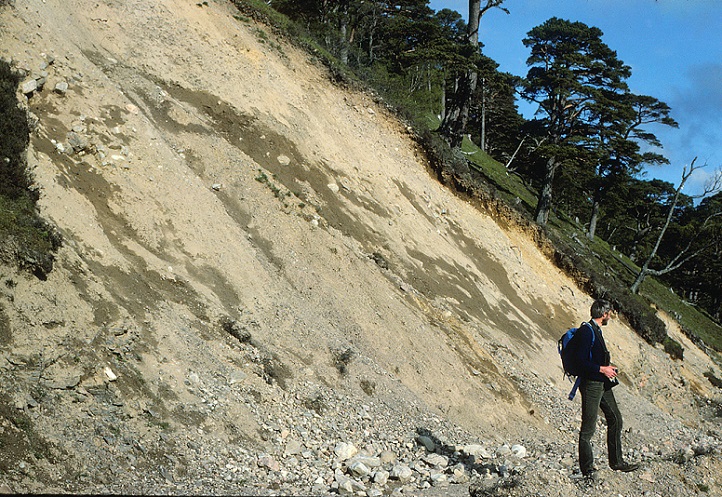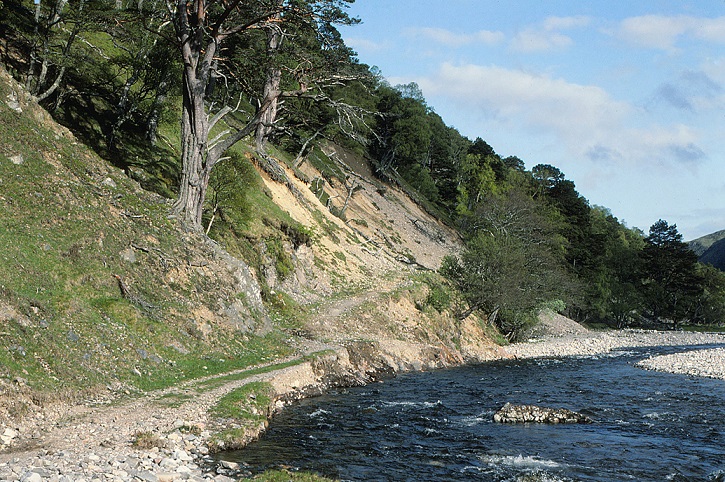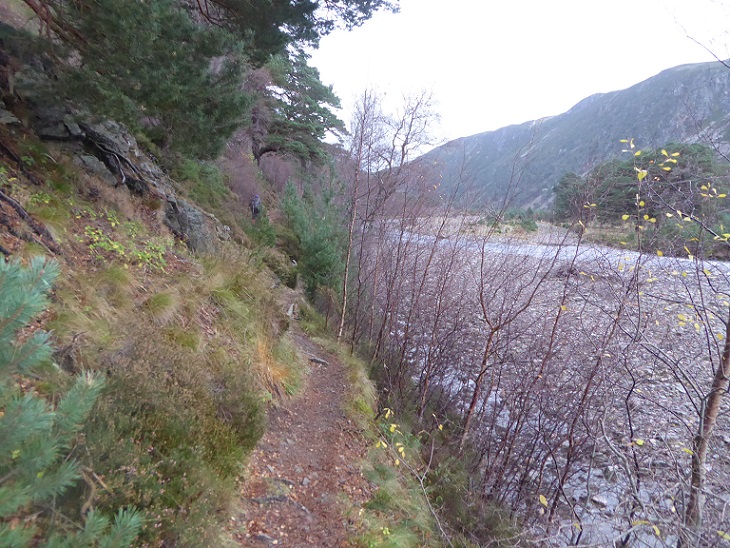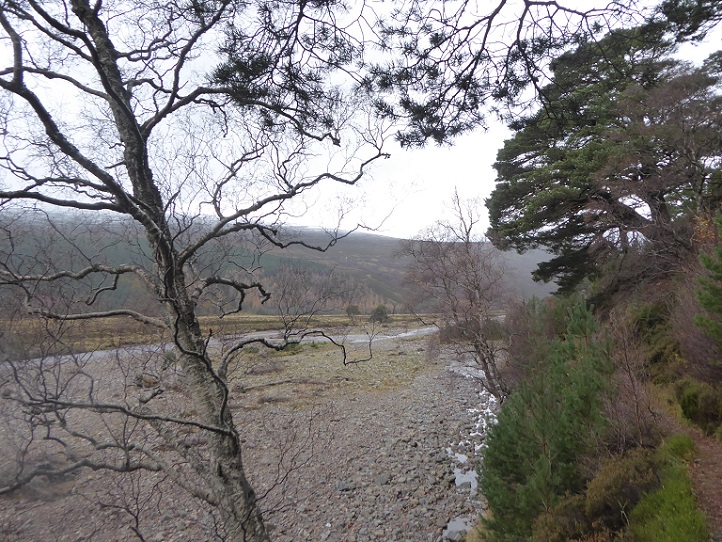
Dave Morris paid tribute to Adam Watson, the great ecologist of the Cairngorms, shortly after his death (see here) but Parkswatch has done little else to celebrate and promote his work and legacy. Over the last year Jenny Aitchison, Adam’s daughter, has been sending me copies of photos he took in the Cairngorms, starting with Cairn Gorm itself. It is an incredible record, which will be deposited in the special collections at Aberdeen University, and I have been wondering how best to make use of the photos on parkswatch.
Whence the idea for a series of posts over the course of 2022 comparing what Adam observed with what is happening now. And because the new year is traditionally a time for optimism, there is no better place to start with a couple of Adam’s photos of Glen Feshie.

These two photos from Adam show that in 1983 Glen Feshie was in a terrible state. The Caledonian Pine Forest was dying and ground vegetation had been grazed to its roots, creating patches of bare earth. The land was disintegrating, as it still is elsewhere in the Cairngorms National Park (see here), the Loch Lomond and Trossachs National Park (see here for example) and much of the rest of Scotland (see here). The primary reason of course was, and still is, overgrazing.
Adam and those he influenced, like Dick Balharry and Dave Morris who is featured in the top photo, understood the cause of the problem. But when Dave, then employed by the Nature Conservancy and working out of their Aviemore office, tried to make the Cairngorms National Nature Reserve worthy of the name and tackle the deer issue, Lord Dulverton, who then owned Glen Feshie, spoke to the powers that be and had him transferred down to Peterborough!
That power of the traditional sporting estate landowners has hardly changed. But twenty years ago Glen Feshie was bought by the first of a new type of landowner, one which saw that what was important was the state of the land as a whole, not the numbers of deer and red grouse. The transformation of the land shown in Adam’s photos has been dramatic.
 I had walked up Glen Feshie beyond Ruigh Aiteachain at the end of November, on a mixed day with a faulty camera, and before I had received Adam’s photos of the collapsed track and landslip. My two photos therefore don’t provide an exact comparison of then with now, while the track has since the landslip taken a different route up the glen. But my poor photos still show enough: instead of bare earth, with the river bank vulnerable to erosion from every flood, a profusion of vegetation.
I had walked up Glen Feshie beyond Ruigh Aiteachain at the end of November, on a mixed day with a faulty camera, and before I had received Adam’s photos of the collapsed track and landslip. My two photos therefore don’t provide an exact comparison of then with now, while the track has since the landslip taken a different route up the glen. But my poor photos still show enough: instead of bare earth, with the river bank vulnerable to erosion from every flood, a profusion of vegetation.
 On the walk, we passed the site of the landslip which is still very obvious but is now covered with vegetation which is slowly reducing the rate of erosion. I thought it worth a photo but unfortunately my camera had almost packed up at that point – if any reader is up there, further photos would be gratefully received! It’s a place that every member of the Cairngorms National Park Board, the Minister for National Parks and indeed those custodians of the the traditional sporting estate, the Royal Family, should visit.
On the walk, we passed the site of the landslip which is still very obvious but is now covered with vegetation which is slowly reducing the rate of erosion. I thought it worth a photo but unfortunately my camera had almost packed up at that point – if any reader is up there, further photos would be gratefully received! It’s a place that every member of the Cairngorms National Park Board, the Minister for National Parks and indeed those custodians of the the traditional sporting estate, the Royal Family, should visit.
For people wanting to get a sense of what Adam Watson was like as a person, I highly recommend the podcast from the BBC archives of Adam walking the Lairig Ghru with Tom Weir. This was published by Scotland Outdoors on 29th December and is available for the next year (see here). The breadth of subjects covered is extraordinary. It includes Adam talking about the impact of extreme rain events and landslips in the Lairig Ghru (at 13 mins 30 seconds), three years after the photos featured in this post.
Adam was – like Dave Morris and as he recorded on parkswatch – shunned by much of the Scottish establishment for speaking the truth about what was happening in the Cairngorms. No place on the National Park Board for the likes of him. His photos provide evidence for many of the arguments he was involved with at the time and, as I hope to demonstrate over the course of the year, that in much of the Cairngorms not much has changed. His concerns about what was happening in the Cairngorms remain as relevant as ever.
But to start on an optimistic note, Adam’s Glen Feshie photos show dramatic change for the better is possible. Its a tempting metaphor to say that he would be smiling from heaven.
Happy New Year!
Very much looking forward to these posts.
For your Feshie comparison. A view of the pretty barren glen floor under the old pines as late as 2006. The track from the bothy towards the top of thevGlen. Nowadays young growth restricts the view to 100m or so.
https://www.crazyguyonabike.com/pics/docs/00/00/19/18/small/feshietrack.jpg?v=2T
On from the same date nearer the landslip
https://www.crazyguyonabike.com/pics/docs/00/00/19/18/large/upperglenfeshie.jpg?v=2s
Good article.
By 1997 Glen Feshie was possibly in an even worse state than when Adam took those photos. I visited to take some similar photos of the then desolation of Glen Feshie on what turned out to be a very wet day, by which time that collapsed track had collapsed even more to form a huge bowl containing several large dead pines that had been undermined by its growth, whilst hundreds of tonnes of the unconsolidated glacial debris that underlie that land had since fallen into the River Feshie.
The project nearly cost me my life: I was standing on the remains of the track at the base of the bowl taking a photo looking upwards when I heard a crash and saw a boulder the size of a horse’s head careering down the steep slope straight towards me. Transfixed, I was trying to work out whether to dive to the left or the right when the boulder hit just about the last large pine stump above me, and was stopped dead.
Amazing story Roy, if you have the photos in electronic format I would be very happy to publish them or you would be welcome to write a post!
Adam and I used to go on site visits at the weekend to all sorts of places. I learned much from him and he learned at least some things from me due to my experience in agriculture etc. We visited Glen Feshie together several times and the point where the glen swings. The photos are where the glen swings and track went along the outside of the curve. Sandy Walker, who some will remember, was a soils expert with the then Macaulay Institute and easily the best applied soil scientist I ever knew. His insight into the Highland Landscapes was fantastic. He looked at that situation in Glen Feshie and said they put the track down the wrong side of the glen. When the glacier came down the glen shaping it, it pressed harder against the slope on the outside of the curve, steepening it and pressing soils etc onto that slope. OVERSTEEPENING IT! If you then cut into that oversteepened slope lower down you destabilised it and you got masses of soil and rocks slowly collapsing onto the track – which was what happened. Adam and I used a photo of that situation in Glen Feshie when we published out booklet The Future of the Cairngorms. Other visits to Glen Feshie saw other problems. Lord Dulverton, the then owner tried to expand the Caledonian Forest by ploughing the ground and planting pines from nurseries. Adam and I visited these plantings. Deer could get access to these plantings somehow. The bare ground created by ploughing was ideal for natural regeneration and it was thick. However, deer, grouse, hares etc ate expert at selecting more nutritious feed and nursery grown seedlings grown on more fertile ground are more nutritious. So the nursery ones were simply browsed out. Ah me!
Really enjoyed this piece and am looking forward to more reflections on Adam’s work. There has been a lot of focus on Nan Shepherd’s Living Mountain in recent years and while it is a book I like a lot Adam’s contribution to knowledge about the Cairngorms is unrivalled and should also be celebrated.
Great stuff. What chance a big exhibition (Aberdeen Art Gallery?) of his photos, alongside new photos of the same locations?
Dave, a very nice idea. I think it would need help from far better photographers than I who were prepared to take or supply photos from the same location – that might not be that difficult, I have already been sent a number of photos of the area around the landslip and of the landslip itself. Let’s see how it goes but I will pass the suggestion to a few contacts in the North East.
On second thoughts, perhaps the Cairngorms National Park Authority might take it on?
Nick
Seems that this could be something for the Cairngorms Archive Trust
https://www.cairngormsarchive.org.uk/who-we-are/
That would be neat!!